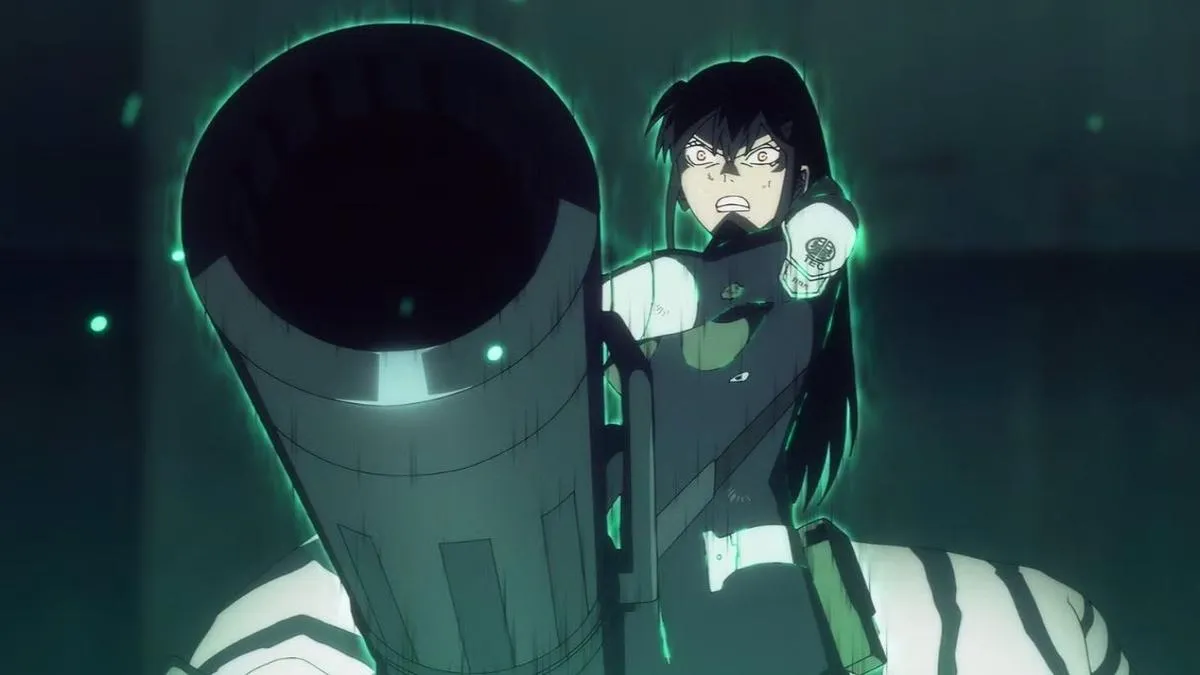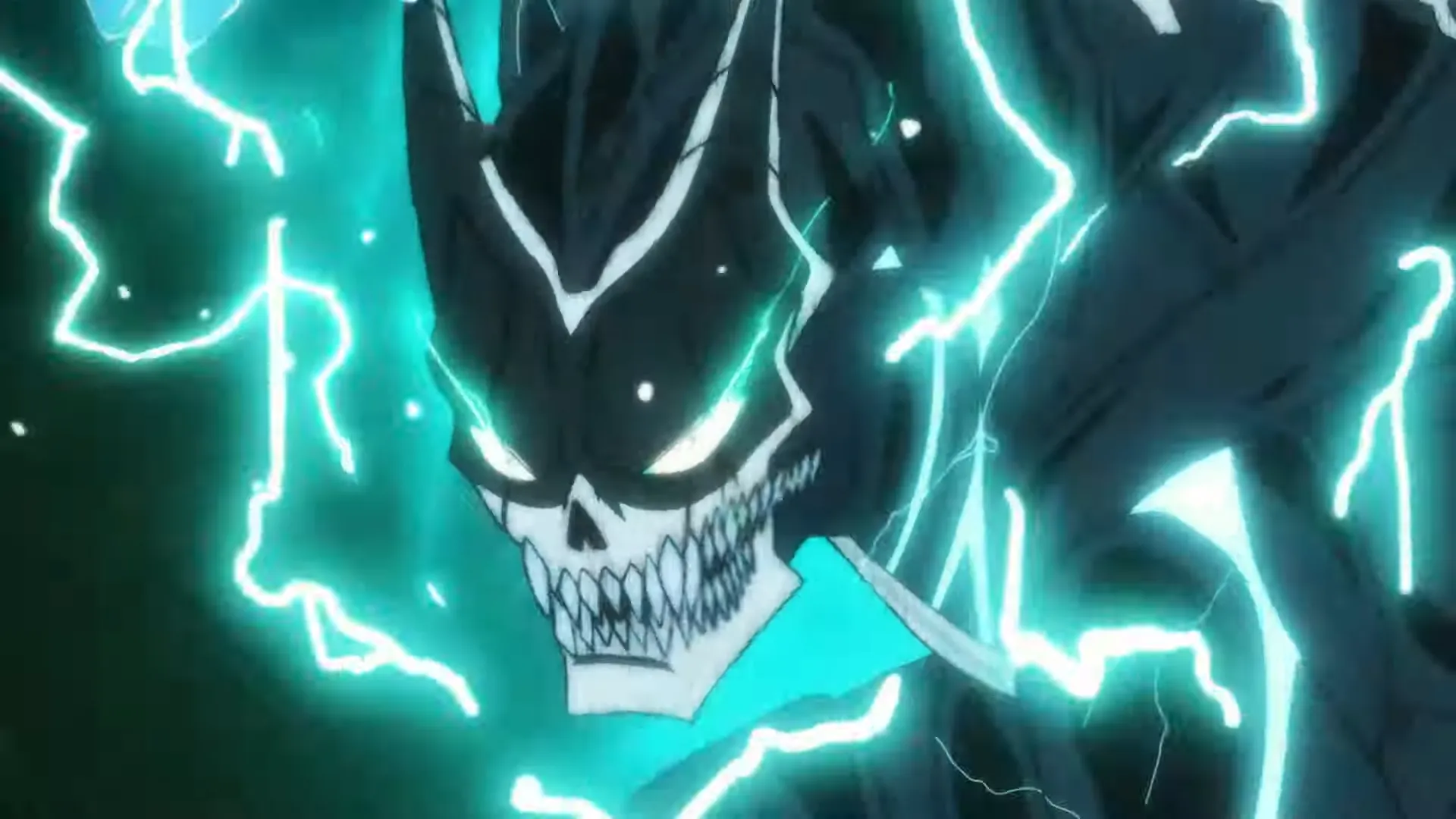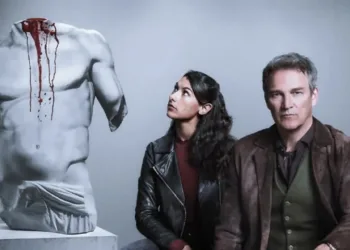In this film, the bustling urban backdrop is relentlessly menaced by enormous creatures, and the very fabric of society is rearranged by this constant threat. The story unfolds within a unique training facility reminiscent of a high-school academy, where recruits learn their craft through hands-on, rigorous combat scenarios.
At the center is Kafka Hibino, a low-ranking janitor with an unexpectedly extraordinary destiny. His accidental acquisition of transformative powers introduces a fascinating dichotomy: a man burdened with quotidian chores who suddenly commands awe-inspiring might in his monstrous form.
The narrative plays with familiar storytelling forms by compressing a lengthy seasonal arc into a brisk, exhilarating recap that also introduces fresh material. The film shifts seamlessly between moments of intense, fast-paced encounters and quieter episodes that spotlight personal interactions among members of the Defense Force.
This mix creates a rhythm that is both engaging and accessible, striking a balance between heart-pounding action and genuine character interplay. The visual execution—ranging from dynamic, sweeping urban sequences to intimate, expressionistic cuts—works in tandem with a powerful musical score and precise editing to craft a memorable cinematic experience. Drawing on experiences with French New Wave and contemporary directors alike, I found that the film reinvents familiar procedures while inviting the audience to witness an unexpected transformation in both form and spirit.
Plot Structure and Narrative
The film wastes no time reestablishing its universe—a city constantly challenged by massive creatures, with a Defense Force that trains its recruits in a setting reminiscent of a school. Early scenes remind us of a structured hierarchy and established routines amid chaos, where the regular occurrence of monstrous attacks sets a relentless pace for the narrative.
We meet Kafka Hibino, whose past is marked by shortcomings that left him on the outskirts of the elite monster fighters. His dream is clear, even if his early experiences have kept him in a supporting role. Kafka’s yearning for recognition and a chance to contribute fully is built steadily through carefully placed flashbacks and brief interactions that underscore his commitment and personal struggles.
A turning moment arrives when Kafka encounters a mysterious creature; an encounter that alters him via an unexpected transmission of power by a parasite associated with one of these behemoths. This event jolts his ordinary existence into an entirely different reality, as he finds himself burdened with new abilities along with a host of pressing responsibilities. The film uses this incident to spark tension between the remnants of his old, familiar life and the potential for a radically changed destiny.
The narrative is trimmed to fit within a 90-minute timeframe, turning a season-long saga into a concise, high-energy presentation. This approach introduces challenges in pacing, as the film juggles a brisk retelling of familiar plots with sufficient material to capture the uninitiated.
Additional plot points, including supplementary episodes that offer glimpses into the varied experiences of the Defense Force, are woven into the main thread. Abrupt shifts and loose ends are apparent at moments, yet the film maintains an energetic forward motion, keeping viewers engaged as it moves through a tapestry of training sequences, personal growth, and tactical showdowns.
Character Analysis and Relationships
Kafka Hibino emerges as a relatable and layered figure within the film’s expansive roster. His background as a routine janitor with aspirations toward a highly respected military unit paints a vivid picture of human fragility amid extraordinary circumstances.
Kafka’s struggle is evident in his contrast between an everyday life of menial work and the sudden onset of potent powers acquired after his unexpected transformation into a monstrous hybrid. This shift brings internal pressure and highlights the solitude that often accompanies sudden strength and responsibility. His predicament recalls the existential queries posed in the films of Godard or Truffaut, where personal aim collides with societal expectations.
Mina Ashiro plays a central role as a steadfast member of the elite Defense Force, serving as both a benchmark for heroism and a subtle counterpoint to Kafka’s softer, more human qualities. Their shared past and complex relationship carry undertones of rivalry and solidarity, providing a dynamic interplay that is both warm and tension-filled. Reno Ichikawa steps in as a steadfast supporter whose encouragement rekindles Kafka’s resolve. His presence infuses the narrative with moments of levity and human connection, suggesting that determination can be nurtured through camaraderie.
Other key figures such as Kikoru Shinomiya and Soshiro Hoshino enrich the narrative further. Their interactions—marked by witty exchanges and competitive spurts—add a layer of multidimensional teamwork. These relationships help to paint a broader picture of life in an organization under extreme pressures, where personal aspirations meet collective duty.
In examining these interpersonal dynamics, it becomes clear that the film uses its characters to mirror the tension between individual ambition and communal responsibility. This exploration of human ties forms an essential element of the narrative, inviting audiences to reflect on what it means to pursue greatness while staying rooted in personal identity.
Animation, Visual Style, and Soundtrack
The film brings a striking combination of 3D camera sweeps of urban sprawls and lively 2D sequences that give a fresh look to each scene. The way the visuals shift during battles and quieter moments creates an engaging interplay that holds the viewer’s attention from start to finish. There are flashes where animated characters seem almost as expressive as if they were actors on a minimalist stage—reminding me of inventive moments from a French New Wave classic.
Certain scenes use playful cutaways, similar to a series of lively visual cues that convey raw emotions. This method sharply contrasts with the detailed fight sequences, where the intensity of each confrontation is amplified by the clear and deliberate shifts in the visual style. The film’s approach to character emotions through these quick visual interludes paints a picture that feels modern yet familiar, reflecting on themes seen in films of both independent studios and large production houses.
The design of the giant creatures draws inspiration from Japanese tokusatsu classics, reimagined with a touch that hints at cosmic horror. The use of special effects makes the creatures impressive to watch while still retaining aspects reminiscent of older genre icons.
The musical score plays an active role in shaping the film’s atmosphere. Rhythmic beats and sound cues heighten the tension during intense sequences, while softer tones accompany the more reflective or personal moments. In many scenes, the sound works in concert with the animation to guide the viewer’s emotions, resulting in an experience that speaks clearly to contemporary cinematic tastes.
Action Sequences and Battle Choreography
Major fight scenes command attention through fluid combat movements and the presence of bold, dynamic poses that reveal each character’s tactical strengths. Kafka’s inventive use of his newfound power is on display as his confrontations mix brute force with cunning strategy. These moments are constructed with clear precision, where every strike and evasion serves as a visual reflection of his evolving role in the story.
Group battles, featuring extensive clashes against colossal creatures, form a stark contrast with intimate duels between individual combatants. In the large-scale conflicts, coordinated movements and sprawling action sequences bring energy to the screen, while one-on-one moments highlight the character’s resolve and personal challenges. This shift in focus enriches the viewer’s experience and distinguishes between the broader conflict and personal stakes.
Quick cuts and well-timed sound effects add an extra punch to the visual drama. The blend of rhythmic percussion and resonant musical cues intensifies each strike, underscoring pivotal shifts in the narrative. The integration of computer-generated effects with practical methods creates a sense of tangible impact, making the destructive force of the beasts feel real and immediate.
The production techniques draw on traditional elements that one might recall from celebrated tokusatsu works, yet they incorporate modern animation innovations. Each battle not only entertains but also marks a significant moment in Kafka’s transformation, showing the heavy cost of newfound power and the self-sacrifice required in the fight to protect his city.
Thematic Elements and World-Building
The film uses transformation as a key idea through Kafka’s shift from a janitor to a creature with formidable power. His struggle with a changed identity lays out questions about who we are beneath the surface and the masks society expects us to wear. Kafka’s personal challenges, seen in his balancing act between everyday duties and sudden strength, reveal the high price that change can bring. His push for respect in a strict system gives insight into the heavy cost of ambition.
The story also examines the sacrifice demanded by a life lived under constant threat. Characters make hard choices in moments when safety seems distant, and the shared burden of duty leaves its mark on everyone involved. This pressure is felt on a personal level, affecting each individual as they work hard to meet the expectations of the Defense Force.
The city itself plays a vital role. Worn by unending attacks, its crumbling structures and makeshift defenses speak of an ongoing struggle for survival. The environment is portrayed as a living presence; its scars and resilient spirit mirror the challenges faced by its inhabitants. Within this framework, the Defense Force operates with a mix of rigid order and moments of unexpected humor. These personal interactions, marked by light banter and mutual support, lend a sense of realism to the fight against chaos.
Subtle hints scattered throughout the film suggest that further trials and unresolved issues lie ahead. These suggestions add depth to the setting and encourage the viewer to consider future developments, while also reflecting the everyday pressures and uncertainties present in our own world.
Bonus Content Integration and Concluding Thoughts
The additional segment, “Hoshina’s Day Off,” provides a lighthearted breather amid the tension of endless monster clashes and high-stakes confrontations. This bonus episode stands on its own, offering humor and a gentle look at the everyday side of the characters. Its placement feels like a well-timed break that invites a closer look at figures such as Soshiro Hoshino. We see a different side of him—one that is less caught up in the chaos of combat and more connected to simple, human moments.
This section of the film serves as a narrative palate cleanser, inviting viewers to appreciate the softer moments that add depth to the overall experience. The brisk pace of the primary storyline finds balance in these quieter interludes, which enrich our understanding of the cast beyond the spectacle of battles.
At the same time, the film keeps its focus on a fast-paced narrative, an inventive visual style, and a rich interplay of action and thematic ideas. My personal memories of watching French New Wave works and contemporary dramas often evoke a similar mix of adrenaline and reflective pauses. The film captures the rush of epic confrontations while celebrating the inner lives of its characters, hinting at promising twists in the installments to come.
Full Credits
Directors: Shigeyuki Miya, Tomomi Kamiya
Writer: Ichirō Ōkouchi
Cast: Masaya Fukunishi, Wataru Katō, Ai Fairouz, Kengo Kawanishi, Yūki Shin, Asami Seto, Shunsuke Takeuchi, Hikaru Midorikawa, Tesshō Genda
Composer: Yuta Bandoh
The Review
Kaiju No. 8: Mission Recon
Kaiju No. 8: Mission Recon delivers energetic combat and heartfelt character moments that expand its universe while retracing familiar narrative paths. The film features imaginative visuals, a brisk pace, and a bonus segment that offers a welcome break. Minor pacing issues surface at times, yet they hardly diminish its engaging storytelling and thematic depth. This project comes across as a dynamic and entertaining experience, engaging both longtime fans and newcomers alike.
PROS
- Engaging action sequences with dynamic fight choreography
- Inventive visual style combining 2D and 3D techniques
- Heartfelt character development and relatable protagonist
- Clever bonus segment that adds humor and depth
- Well-integrated soundtrack that heightens the action
CONS
- Compressed narrative may feel rushed for some viewers
- Abrupt transitions that leave a few threads unresolved
- Limited focus on secondary characters in the main arc





















































